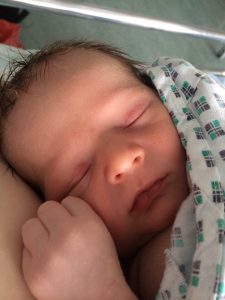In 2014, NICE published their guidance on co-sleeping and Sudden Infant Death Syndrome (SIDS).1 NICE downgraded the relationship between co-sleeping and SIDS from a ‘risk’ to an ‘association’. This significant change reflects the lack of clear evidence that co-sleeping causes SIDS. Although some of the evidence reviewed showed that there is a statistical relationship between SIDS and co-sleeping, the guidance update does not differentiate between different co-sleeping locations (it defines co-sleeping as sleeping on a bed or sofa or chair with an infant), or infant feeding type. It can be argued that the overall ‘association’ results from not distinguishing between bedsharing and co-sleeping in a sofa or chair (BASIS online, NICE update). This is consistent with the information on the UNICEF Baby-friendly Initiative leaflet “Caring for your baby at night, health professional’s guide”. The leaflet states: “Although there is an association between bedsharing and SIDS, increasingly the evidence suggests that it is not bed-sharing per se that is a risk factor, but the circumstances in which it occurs”.2
Bedsharing is relatively widespread, and it is not related to maternal age, family situation or social class (Blair and Ball, 2004). Almost half of all babies bedshare with their parents at some point in their first year of life (Blair and Ball, 2004).3 Research suggests that breastfeeding duration is strongly associated with bedsharing (Blair and Inch , Blair and Ball, 2004; Ball et al, 2016;).2,3,4 Breastfeeding mothers who bedshare are more likely to breastfeed for longer, and more likely to follow the recommendation of keeping the baby in the same room for the first 6 months of life. They frequently touch their babies, monitoring the baby’s temperature. If a baby is not feeling well, this may be more easily recognised when she/he is close to the mother. McKenna et al (2015) have coined the term “breastsleeping” to distinguish “the significant differences (and associated advantages) of the breastfeeding–bedsharing dyad when compared with the nonbreastfeeding–bedsharing situations, when the combination of breastfeeding–bedsharing is practiced in the absence of all known hazardous factors”.5
A blanket message to avoid bed-sharing is unhelpful. According to Ball et al (2016),3 “Parent–infant bed-sharing is neither uniformly risky nor safe for infants; it is therefore important to anticipate which mothers are most likely to bed-share, to understand how risk might vary for each group and to tailor appropriate guidance that balances risk minimisation with support for breastfeeding mothers”.
Breastfeeding mothers need to make an informed decision on where their baby sleeps, for which they need full information on the benefits and risks of all approaches (Blair and Inch, Ball et al, 2016).4 The following are some resources which can be used to support them.
- Caring for your baby at night leaflets, by the UNICEF Baby-friendly Initiative. Both the parents’ leaflet, and the accompanying health professional’s guide can be downloaded from the UNICEF Baby-Friendly website (http://www.unicef.org.uk/BabyFriendly/Resources/Resources-for-parents/Caring-for-your-baby-at-night/ ). The guide for health professionals (by Blair and Inch) provides very detailed information about the evidence underpinning the recommendations mentioned in the parents’ leaflet. (http://www.unicef.org.uk/Documents/Baby_Friendly/Leaflets/HPs_Guide_to_Coping_At_Night_Final.pdf)
- Baby Sleep Information Source (BASIS) Online. This website is a collaboration between Durham University Parent-Infant Sleep Lab, La Leche League, NCT, and UNICEF UK Baby Friendly Initiative (ISIS Online). https://www.basisonline.org.uk/ Babies, whether bottle or breastfed, wake up often to feed, and parents need to know that, although it may not conform to society’s expectations, this behaviour is normal from a biological point of view. This website addresses “normal” infant sleeping patterns. It also includes a repository of free images depicting safer co-sleeping/bed-sharing, which can be used by media, businesses and health care professionals (https://www.basisonline.org.uk/image-archive/).
- Safe Sleep and the Breastfed Baby Leaflet, available from the LLLGB Shop (http://www.lllgbbooks.co.uk/store/p5/Safe_Sleep_%26_the_Breastfed_Baby.html). This leaflet, aimed at parents, provides information on the risks and benefits of bedsharing depending on each family situation. It also explains how parents can reduce risks, and provides detailed suggestions for making a baby’s sleeping place safer, wherever she/he sleeps.
- Sweet Sleep: Nighttime & Naptime Strategies for the Breastfeeding Family, by Diane Wiessinger, Diana West, Linda J. Smith, and Teresa Pitman. Available from the LLLGB shop (http://www.lllgbbooks.co.uk/store/p89/Sweet_Sleep%3A_Nighttime_%26_Naptime_Strategies_for_the_Breastfeeding_Family.html). The book, aimed at parents, cover normal infant sleep patterns, and how to make a baby’s sleeping place as safe as possible. It addresses the concerns with sleep training regimes. It also reviews what research says about bedsharing and SIDS in a “reader-friendly” way. Finally, it also discusses gentle techniques to encourage babies to sleep for longer stretches when they are ready. In the preface, Prof Helen Ball writes “[…] breastfeeding mothers and babies bedshare, and do so whether they are advised against it or not. It is a baby care strategy that makes sense to breastfeeding mothers, and it works for reducing the disruption of frequent night feeds, maintaining breastfeeding, and meeting their babies’ emotional needs and their own sleep needs simultaneously… This book gives guidance not only on whether to bedshare but also how to bedshare as safely as possible.”
References
1 NICE guidance on SIDS and co-sleeping (2014) Postnatal care up to 8 weeks after birth, 1.4 (Maintaining infant health), sections 1.4.47 to 1.4.49
2 Blair P, Inch S. Caring for your baby at night, health professional’s guide, UNICEF Baby-friendly Initiative http://www.unicef.org.uk/Documents/Baby_Friendly/Leaflets/HPs_Guide_to_Coping_At_Night_Final.pdf
3 Blair P, Ball H (2004) The prevalence and characteristics associated with parent–infant bed-sharing in England, Arch Dis Child, 89, 1106-1110. DOI:10.1136/adc.2003.038067http://m.adc.bmj.com/content/89/12/1106.full
4 Ball H., Howel D., Bryant A., Best E., Russell C., Ward-Platt M. (2016) Bed-sharing by breastfeeding mothers: who bed-shares and what is the relationship with breastfeeding duration?, Acta Paediatrica, 105 (6), 628-634. DOI 10.1111/apa.13354
http://dx.doi.org/10.1111/apa.13354
5 McKenna, JJ, Gettler, LT (2016) There is no such thing as infant sleep, there is no such thing as breastfeeding, there is only breastsleeping, Acta Paediatrica, 105(1), 1651-2227. DOI: 10.1111/apa.13161. http://dx.doi.org/10.1111/apa.13161

